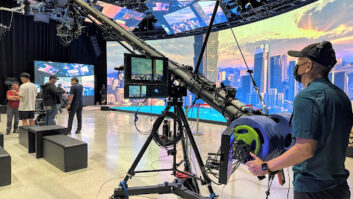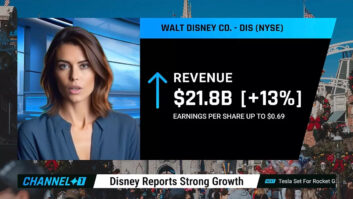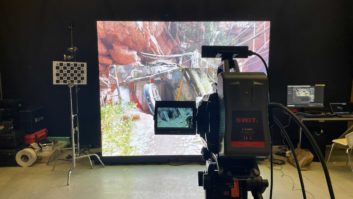Within the next five years advances in display technology will make science fiction reality, with screens that are unobtrusive, frameless, ambient and Ultra HD. So claims Cisco, which will be backing up its statement at IBC with an evolved prototype of its Fresco video wall.
Demonstrated in private at IBC2012, the second phase prototype features two, as opposed to one large display in a single room and is also on the show floor this year available for all to see.
“This is a future of video that breaks out of the box in the corner of the room,” said Christelle Gental, marketing manager, SP Video. “Fresco demonstrates that television’s future is both collective and personal, and shows a new relationship between large screen and companion devices.
“No one has ever shown such adaptability before,” she claimed. “Our display engine, driven by user input and content metadata, automatically manages the layout of content to meet the needs of the audience, and provides web-based UIs on a range of companion devices, giving a unique combination of the collective and personal.
The prototype uses professional monitors with 5mm bezels, but OLED offers the prospect of a bezel width of near zero.
“Even with today’s widths there is the real option of creating large Ultra HD displays out of tiled arrays of inexpensive screens,” explained Cisco’s Simon Parnall and James Walker in a white paper on the technology. “While still in the research labs, transparent displays which allow the underlying environment to show through are starting to emerge as niche products. These would allow the blending of displays into the room environment.”
The viewer is able to add or remove components or re-arrange the layouts of the dual large displays via a companion device. This opens up a number of intriguing questions about the TV of the future, how it is produced, delivered, presented and interacted with.
Content challenges
“Perhaps most challengingly, we need content producers and designers to understand that their content can and will be presented in many different ways, and a complete control over this presentation is potentially very counter-productive to the viewer’s engagement,” wrote Parnall and Walker.
“Today’s television makes the basic assumption that ‘the display is always filled’ regardless of the size of display, quality of the video, or the impact of an oversized face or object; and it also effectively does only one main thing at a time. With larger, higher resolution displays this implicit behaviour can be challenged. Content need no longer necessarily fill the display, and the display can simultaneously be used for many different components.”
The opportunity theoretically opens up possibilities way beyond the limits of today’s devices through, for example, content comprising multiple visual elements that can be adapted spatially and temporally, “freeing the user from choosing a single element, or the system from having to impose overlays.”
Another opportunity lies in supporting connected applications and services operating in a more streamlined, integrated manner, reflecting and effecting changes in viewer engagement in TV content.
Immersive technology
“Immersion is key to the way that the displays are used and the way that the content is presented on them,” the white paper stated. “Put simply, the more immersed in the content the viewer is, the greater emphasis that is placed on the core video, and the less immersed they are the more emphasis comes to be placed on related content which may then be introduced. This related material could be social media, advertising, programme graphics, additional material, or virtually anything.”
In Fresco, immersion is controlled in two ways: via metadata that indicates the broadcasters expected level of immersion; and also via a control in the companion device that allows the user to modify the immersion as they wish.
“Clearly other mechanisms could also be employed, such as audio or video analysis of the room and the viewers, but the prototype shows that these two simple mechanisms work very effectively.”
The first prototype was built using a single, six-output computer (an AMD Eyefinity graphics card in a powerful PC) with software that was itself built on standard HTML5 technologies (e.g. JavaScript and CSS transitions) in functionality largely contained within a standard browser.
The new architecture is designed to support multiple large-display clients, and Cisco has been exploring how these can be combined for the presentation of a single entertainment experience.
For example, it said, in addition to displaying further content elements, to supporting a ‘watch party’ where the viewer’s couch can be ‘virtually’ extended onto the second display to give an ambient shared viewing experience with remote friends or family.
“We have also explored how the two displays can co-operate to support multiple simultaneous entertainment experiences such as sports matches or soap operas.
It continued: “The tradition of a television picture scaling up to fill the display means that an object is effectively displayed at an unknown size. With this assumption broken, it now seems realistic to allow an object to be displayed at its real size, regardless of the display (as displays report their size through the standard connectors). For instance, in advertising it could be interesting to show just how thin the latest phone really is, just as is possible in print media today.”
By Adrian Pennington






